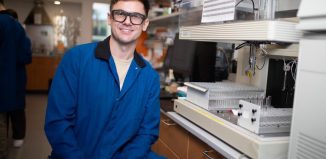State-of-the-art medical imaging at Stony Brook
A man walked into the emergency room at Stony Brook recently with chest pain. At first, the doctors thought he might have a pulmonary embolism, or a blockage of the main artery in the lungs. It could also have been heart disease.
Unsure of the diagnosis from his symptoms, the doctors performed a procedure called coronary computed tomography angiography. Quickly, they realized the man had 90 percent obstruction of the coronary artery.
“He had a stent put in and he was fixed,” said Mark Henry, a professor and chairman of the Emergency Medicine Department at Stony Brook.
The CCTA test allowed the doctors to perform a procedure that likely kept him from having a heat attack that might have killed him.
Michael Poon, a professor of radiology, medicine and emergency medicine and director of advanced cardiovascular imaging at Stony Brook, helps make this test available seven days a week at the school.
“Dr. Poon deserves a lot of credit,” Henry said. “We’re really happy to be able to offer that to our population.”
Henry estimates that Stony Brook does more CCTAs than any other hospital in the country. Poon advanced the state of the art at the school in terms of imaging, Henry said, while also reducing the amount of radiation exposure to “the lowest possible level.”
Poon published a paper in 2013 showing that this technique saves money and cuts down on time in the emergency room.
“Nine out of 10 times, [chest pain] is a false alarm,” Poon said. “We didn’t have an accurate test to screen out that one out of 10. We ended up admitting everybody because we can’t afford to miss one.”
This test cuts down the length of stay in the ER dramatically, Poon said. Once patients get a clear diagnosis, they don’t tend to return with the same uncertainty to the ER with the same symptoms, Poon said.
Poon’s paper on this method recently won a Minnies award for Scientific Paper of the Year. The Minnies awards provide a way for radiology experts to recognize the contributions of their peers in medical imaging. Poon said he was honored to receive the recognition.
In 2002, Poon became intrigued by the possibilities of this imaging technique when he was at Mount Sinai Hospital. He was involved with research into noninvasive imaging of the coronary artery, the tube that supplies blood to the heart.
“When I saw the early images from Germany using CCTA, I said ‘I have to learn this,’” Poon recalled. He invited the University of Munich team to spend a year with him, during which he learned about the procedure.
The beauty of this test, Poon said, is that it gives a clear diagnosis with the highest negative predictive value among all noninvasive tests. This method is also a way of detecting plaque in the heart, which can be an early indication of heart disease.
In addition to conducting research, Poon sees patients three days a week. “I’m constantly looking for newer and better ways of doing things,” Poon said.
One of the areas he’s currently working on is called enhanced external counter pulsation. He calls the system “exercising without exercising.” It makes it easier to pump blood through the body at the same time that it sends blood back to the heart while it’s resting. “It’s all done automatically,” he said. “You lay there on the bed and the machine does all the work for you.”
This treatment is approved for angina and heart failure, but Poon believes it could improve the health of people who aren’t in cardiac stress. He uses it himself once or twice a week.
Poon suggests that this system enables blood to flow to other areas farther from the heart more easily.
Poon, who maintains an active lifestyle that includes snowboarding, lives in Harrington Park, N.J., with his wife, Mei. The couple have four children, who range in age from 16 to 27. Poon spends four days a week at university housing.
Poon said he believes a combination of early diagnosis, with tools like CCTA, and early intervention is the best way to help his patients.
“Making early diagnosis without offering some help is not that useful,” he said. “Using pills isn’t ideal, either. The best way is lifestyle modification. We can use really good science to do it.”






